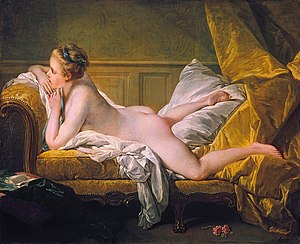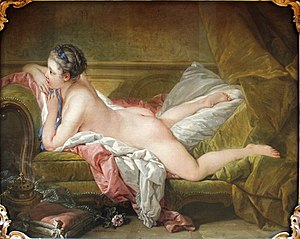art.wikisort.org - Painting
The Blonde Odalisque or Resting Girl (French: Jeune fille allongée, Jeune fille couchée or L'Odalisque blonde) is the title of two oil-on-canvas paintings by François Boucher. The first dates to 1751 and is now in the Wallraf–Richartz Museum in Cologne, whilst the second was produced in 1752 and is now in the Alte Pinakothek in Munich. The model may be Marie-Louise O'Murphy,[1] mistress of Louis XV for two years. They belong to the odalisque genre.
This article needs additional citations for verification. (October 2019) |


Analysis
Boucher's The Blonde Odalisque, or Resting Girl, is filled with soft pastel colors such as pinks, yellows, and blues. The profusion of flowery tones boldly embodies the Rococo era. The nude girl and suggestive symbols throughout the painting help convey an eroticism that is characteristic of much Rococo painting. The different shades of yellow throughout the piece create a serene tone that accentuates the girl's pinkish nude body. The viewer's eye is directed to the girl by the drapes that hang down the side of the room. The open book that seems to be abandoned, the lone rose left on the floor, and even her expression can be interpreted a few different ways. She could either be surprised or anxious. Maybe someone is entering the room that she wasn't expecting, or she could be waiting anxiously for someone to arrive.[citation needed]
Background
Intimacy and delicacy are common themes found in Boucher's work. [[Venus Consoling Love]] and The Triumph of Venus are two of Boucher's other works that convey these themes. Both pieces show how Boucher's work progressed and helped pave the way to creating The Blonde Odalisque'. His painting style is soft and delicate, yet bold brush strokes are representative of common Rococo themes such as delicacy and beauty.
Boucher painted two somewhat different versions of The Blonde Odalisque. The first was made in 1751 and is now in Cologne, Germany. The Cologne version shows the girl resting with a book by her side and a fallen rose in the bottom middle of the painting. The second version of the painting was made in 1752 and is located in Munich, Germany. This version has a small golden box with a lion on the top in place of where the book was in the original version, and it has a different flower on the floor in a different location. The flower is tucked under the bed and is off to the left. The pillows on the floor in the Munich version are much lighter. The Cologne version with the book has a shadow cast over the pillows and some of the book.
Boucher and Marie-Louise O'Murphy met through their affiliation with the Académie royale de peinture et de sculpture in Paris, which is also known as The Academy of Painting. Boucher was the principal painter at the academy when he met Marie and chose her to be his chief model. Boucher claimed to have relied on Marie's looks for inspiration for his future paintings. Marie quickly succeeded as a model at The Academy of Painting and was eventually recognized by King Louis XV and became his youngest mistress.
Marie-Louise O'Murphy
The woman seen in the painting is Marie-Louise O'Murphy, an Irish woman who was also known as Louison. She was born in 1737 and at the age of 14 became the youngest mistress to King Louis XV; she was still only 14 years old when she modelled for this painting. After the painting was commissioned by the French court of the Ancien Régime, The King was so intrigued by the painting that he summoned her for himself. She stayed with The king for two years before she was seen as a threat to The King's other mistresses and was caught asking the King personal questions. She was later asked to leave the Parc-aux-Cerfs, which was what Louis XV's secret brothel was called. Madame de Pompadour, Louis XV's most famous mistress, would regularly dismiss young mistresses for trying to get closer to Louis XV, these accusations are often overlooked.
See also
References
На других языках
- [en] The Blonde Odalisque
[fr] Jeune fille allongée
Jeune fille allongée, ou Jeune fille couchée, également appelée L'Odalisque blonde, est un sujet peint à plusieurs reprises entre 1751 et 1752 par le peintre français François Boucher.[it] Ragazza distesa
Ragazza distesa o Odalisca bionda (in francese Jeune fille allongée, Jeune fille couchée o L'Odalisque blonde) è un soggetto dipinto più volte tra il 1751 e il 1752 dal pittore francese François Boucher. Una tela - risalente al 1751 - è conservata al Wallraf-Richartz Museum di Colonia; una seconda tela, del 1752, è invece conservata nella Alte Pinakothek di Monaco di Baviera. Di questa tela esistono numerose copie, tutte di mano di Boucher.[ru] Отдыхающая девушка
«Отдыхающая девушка» (фр. Jeune fille allongée) — две картины Франсуа Буше 1751 и 1752 годов. Изображающие Луизу О'Мерфи. Первая «Светловолосая одалиска» (1751) сейчас находится музее Вальрафа-Рихарца, вторая «Светловолосая одалиска» (1752) в Старой пинакотеке.Другой контент может иметь иную лицензию. Перед использованием материалов сайта WikiSort.org внимательно изучите правила лицензирования конкретных элементов наполнения сайта.
WikiSort.org - проект по пересортировке и дополнению контента Википедии